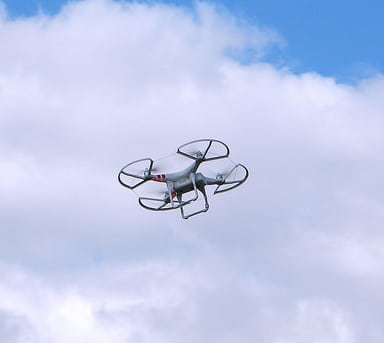Years ago, if the word “drone” was mentioned, odds are the topic of conversation was war or the military. Military drones, also known as unmanned aerial vehicles (UAV’s), have been used on the battlefields since the 1980’s. While drones have been around for about 30 years, the word “drone” has been used more frequently in recent years. Drones have become a recent topic of conversation due to the overwhelming amount of commercial uses they provide. Acute Market Reports has predicted that the global commercial drone market will reach $4.8 billion by 2021. While many people balk at the thought of drones flying through our airways, there are many ways drones are making big strides in innovation in our society. Here are a few:
Search and Rescue: When it comes to search and rescue, drones can impact the field and make a difference from the moment they are used. Certain search and rescue drones are being programmed to search areas inch by inch, making search much more thorough than human search. Not only will drones be much more efficient, they will be able to fit into certain areas humans cannot or should not go. Many areas in a rescue situation are too dangerous and risky for humans to enter, but drones can enter areas without the risk of a life-ending injury. Making and using drones for this line of work is a huge step in making search and rescue missions much more efficient and safe.
Farming: Farming is an art — an art that takes a lot of time and energy to perfect. Years ago, it was very difficult and time consuming for farmers to gather widespread data over an entire growing season. With the use of drones, farmers can fly their drones over an entire farm, collecting pictures and data of how their harvest is growing and what areas need work. Drones also make water and disease management easier and more resourceful. Farming strategies, such as planting and crop rotation and intelligence will be changed forever with the use of agricultural drones. Farmers will be able to cultivate more seasoned crops resulting in a more sustainable and profitable practice.
Film: Drones can also be very helpful in the film industry. Using a UAV to film an exciting car chase or high altitude scene is much cheaper than renting a helicopter, which could cost the crew tens of thousands of dollars. Many drones have the ability to mount and keep a high definition camera perfectly still with the help of a stabilized gimbal.
While drones can be used commercially for very advantageous reasons, if in the wrong hands they can be used incorrectly and even harmfully. Dan Oppenheim, who has been building and flying model airplanes as a hobby for 47 years and drones, or “multi-rotors” as he calls them, for the past two years. Although Dan loves his hobby and the positive uses multi-rotors offer, he agrees that uneducated and naïve flyers give drones a bad name.
“With the advent of the drone and the increasing automation and simplicity to fly, inexperienced pilots can be detrimental to our hobby/industry,” Dan said. “If you fly model airplanes at any club in this country, you are required to have a membership in the Academy of Model Aeronautics (AMA). The AMA is closely affiliated to the FAA and provides all the rules and safety regulations flyers must adhere to.”
As Dan pointed out, anybody can go to a store, buy a multi-rotor, and fly it. The FAA limits drones from flying above 400 feet, but not many people know or follow these rules. There have been reports of drones coming very close to aircraft while above 400 feet in the air.
Recently, there have been news reports of drones crashing in public places such as the stands at the U.S. Open and the White House. The AMA and FAA are teaming up to develop a solution to limit these problems and to punish irresponsible pilots. While Dan cautions us on drones and the pros and cons that come with them, he is very optimistic about the future of multi rotors.
“I think this new industry is here to stay,” said Dan. “My company, Intel, just invested $60 million in Yuneec, another Chinese manufacturer. We have a lot of research and development moving this industry forward.”
Last week at Bell Works in Holmdel, New Jersey, there was a Drone and Robot Conference run by the New Jersey Tech Council. At this event, there were panel discussion and demo sessions all focused around one topic — drones. The future of drones was on display for all to see. Drones were flown over Bell Works’ 1.6 million square foot property to demonstrate the beauty of this technology. The Drone and Robot Conference showed what the field of technology in drones and robots has to offer, and how these masterpieces really have incredible upside.
We are witnessing the future right before our eyes, and are seeing first hand how drones can make a huge impact in today’s society. With proper education and training, drones may just soar into the hearts of many.
TEDxNavesink 2016 is all about society’s makers. Tickets will go on sale soon, but in the meantime, check out what’s happening by signing up for our newsletter. We’ll not only tell you when tickets are available, but you’ll be the first to know all the important TEDxNavesink information. Click here to sign up today.
TEDxNavesink will be held April 9, 2016 at Pollak Theatre at Monmouth University.
Photo courtesy of jacinta lluch valero

